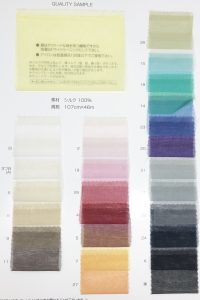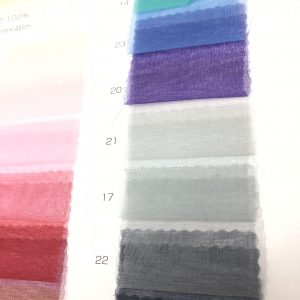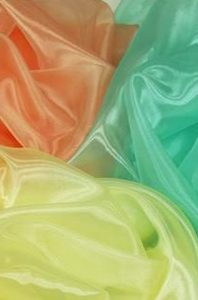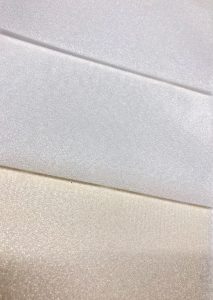Popular fabric in this summer. Let’s take a look at what kind of Organdy Fabric is!
This time, I would like to talk about the fabric called organdy.
Have you ever heard of organdy?
Apparel industry practitioners may have heard of it, but I used to not understand what the difference was between “organdy,” “organza,” and “see-through” fabrics.
In this article, I will explain what kind of characteristics organdy has and what it is used for.
What is Organdy Fabric ?

Organdy is a thin, transparent plain woven fabric. The gap of weave is so coarse that we can even see how the thread is woven, so the density of fabric is very light.
Although organdy is light and thin, it has beautiful glossy. Because the sulfuric acid treatment gives it a taut texture, shine and elasticity of stretch.
What are differences between Organdy and Organza?
Have you ever heard organza ?
When I heard Organdy first time, I thought it must be another name of Organza.
In English, “Organza” is made for silk and “organdy” is made for cotton.
However, there is no difference between them in Japan, they both mean the same fabric.
What are they used for?
Organdy is often used for wedding dresses, corsages and skirts because of its appearance and texture.
In addition, you can see it on stages and window displays because it looks glossy.
Organdy has thermoplastic*, so you can make very unique designs with it.
Recently, multi-material blends have become popular and we often see him in the spring shows. Not only as a main fabric, but also as a good trim for other fabric. It is also used for belt of yukata and kimono, and you can see the new style of Japanese dressing.
* It is not easily deformed at room temperature, but it softens with heat and is easier to shape, and hardens again when it cools.
What is the material of the organdy?
Recently, the use of chemical fibers such as polyester instead of silk and cotton has become mainstream.
The silk organza is called “silk organza”. Silk organza is characterized by the elegant luster and texture of silk, giving it a luxurious feel.
On the other hand, many “polyester organic fabrics” made of polyester are durable and can be washed with water. It is also stronger, cheaper and more affordable than silk. Each has its own strengths and both are very popular.
What is see-through?
“See-through” originally meant “see-through”, and in this case refers to clothing made of very thin and lightweight fabrics.
A wide variety of organdy
As I introduced in this blog, “San Corona Oda”, which has the highest share in Japan, has various organdy fabrics.
Today, we will introduce some of the hottest fabrics of this season.
Silk Organdy


3000 Silk Organic fabrics made from 100% silk have less sheen than polyester and have the characteristic crisp texture of silk.
An organza that combines luxury and elegance.
Crystal Organdy

As the name implies, a mirror organza with more shine than usual.
Air Organdy Fabric

Ultra-fine polyester yarn is used, which is a light fabric that is as thin as air so it won’t fray the fabric.
It is a thin muslin so that you do not feel the weight of the fabric.
Pearl Klepon Organdy

It is an organza fabric woven with glittering threads, giving a glittering and gorgeous impression.
It is a fabric well suited for gorgeous scene clothing.
Chambray Organdy

An organic fabric woven with warp and weft yarns of different colors. It is a kind of fabric that looks different colors according to the angle, and by cutting and overlapping, it will show various styles, and it is a very versatile fabric.
Conclusion
How many types of Organdy you know that not included in this list? Let us know down below!
Organdy is used for a variety of things, from luxurious items such as wedding dresses to everyday items such as underwear, due to its gorgeousness.
By decorating with Organdy, you can easily create neatness and cuteness.
For more Organdy fabric, please visit ApparelX product list!



